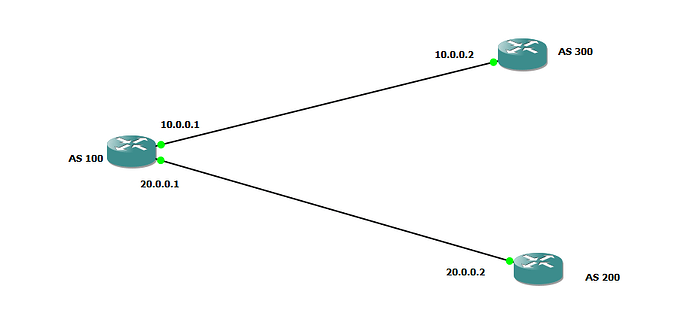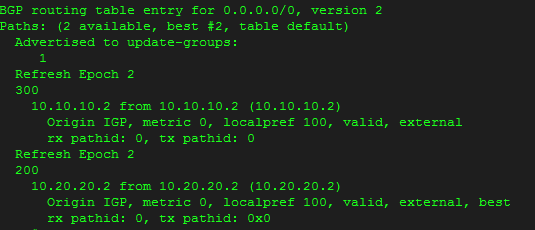This topic is to discuss the following lesson:
Hello Rene,
What mean a network is dampened and History in the BGP table?
Hi Edwin,
I’ll create a separate post for this, it’s about BGP Dampening.
When a route is unstable, it’s possible that it gets advertised and then removed again all the time…we don’t want to see this, we want our BGP tables to be steady and stable.
To prevent this from happening, a route that appears and disappears gets a “penalty”. Once you exceed a certain threshold, it won’t be advertised for a certain time. This is called “dampening”.
I’ll cook up some examples for this so you can see how it works.
Rene
Ok excellent thanks.
Hello Rene
How do you use the glass server?
Take a look at this website:
Scroll all the way to the bottom to this section:
CATEGORY 2 - IPv4 AND IPv6 BGP ROUTE SERVERS BY REGION (TELNET ACCESS)
Here you will find routers/servers with telnet addresses. Just telnet to one of them and you can take a look around in the BGP routing table.
Wow, this is great! Fantastic job!
Hi Rene,
i’m new to bgp and i really appreciate your lesson.
Why R2 show only one path to 4.4.4.4?
I would expect another path with nexthop 192.168.12.1 and AS 1 3 4 as path signed valid but not the best, like R3 does.
Claudio.
Hi Claudio,
Glad to hear you like it. R2 only has one path since R1 only advertises its best path to R2. The best path for R1 is through R2.
A useful command when you have doubts why something shows up or not is the show ip bgp neighbors 192.168.12.2 advertised-routes command. It will show you what you the router is advertising to you.
Rene
Hi Rene,
Firstly I appreciate your knowledge and skills to explain topics in easy way.
My question is we are observing two paths to reach network 4.4.4.4 on R3 router and just one path from R2. Both of them are just one hop away so why this difference is seen in two outputs.
Hello Rene,
I have a question and I am going to use the below topology for the question.
Here Let’s say my AS is 100 and I am connected to two different AS numbers 200 and 300. I am also getting default routes from both of them(from AS 300 and AS 200). My BGP table for default 0.0.0.0 route looks like this:
According to the BGP table, I have 2 available routes for 0.0.0.0 and number 2 is the best route. My question is “why both of the routes have (received & used) beside them?”. I thought only best route would have (received & used) beside it.
Please shed some light on it.
Thank you so much.
Best Regards,
Azm Uddin
Hi @azmuddincisco,
Great question! You are right in thinking that a router running BGP will normally only share its “best” route with another BGP peer. However for its own internal it’s possible the router can push both routes to the RIB and make use of IOS load balancing.
We can check if this is the case by verifying the output of “show ip route”. It would also help to also see the BGP config for the left hand router (including any “maximum-paths” value).
Kind regards,
Jon
Hello Jon,
Thanks for your reply. I do not have maximum-path enabled. Therefore, the router is using only one route as the best path which is 20.0.0.2. Also in the BGP table, 20.0.0.2 has the best path tag on it as we see in the screenshot. My question is why other one(10. 0.0.2) has the tag (received & used) even though it is not being used? Thank you.
Azm
Hello Azm
It may be possible that you have the neighbor soft-reconfiguration inbound command enabled on your router. According to Cisco:
The neighbor soft-reconfiguration inbound command causes the router to store all received (inbound) routing policy updates without modification, for example, a duplicate table is stored in the memory for each peer. This method is memory-intensive and not recommended unless absolutely necessary.
The (received and used usually indicates that the prefix from a soft-reconfiguration-enabled peer was not filtered so it is placed into the regular BGP table. But it is not necessarily the best path.
Check your config and get back to us!
I hope this has been helpful!
Laz
Hey Laz,
You are absolutely correct. Just tested that in the lab and it was exactly what you said.
EXCELLENT !!!
Without Soft -reconfiguration
with Soft-reconfiguration
Azm
so on show ip bgp
if the content displayed has a empty spot on it then its still talking about the network
I know its implicitly stated but I don’t like implicit lol… (unless I get worn out from a particular hard question then sometimes I accept implicit lol)
That’s right!
The > you see in the last entry means that this is the next hop that was installed in the routing table. 203.202.143.33 in your example.
Hi,
I am new to BGP ..
Need little more clarity on difference between following two entries in BGP table :
i.e. network entries vs path entries ?
route-views.optus.net.au>show ip bgp summary
BGP router identifier 203.202.125.6, local AS number 65535
BGP table version is 244799119, main routing table version 244799119
539211 network entries using 69019008 bytes of memory
2321994 path entries using 120743688 bytes of memory
Hello Deepika
The network entries are the total number of unique prefix entries in the BGP database. In other words, these are the total number of destinations that this router knows and for which it has paths available to.
The Path entries is the total number of available paths that have been registered by BGP to these destinations. Because there can be multiple paths to each network destination, this number is usually larger than the network entries.
So as a result, Path Entries >= Network Entries
I hope this has been helpful!
Laz




